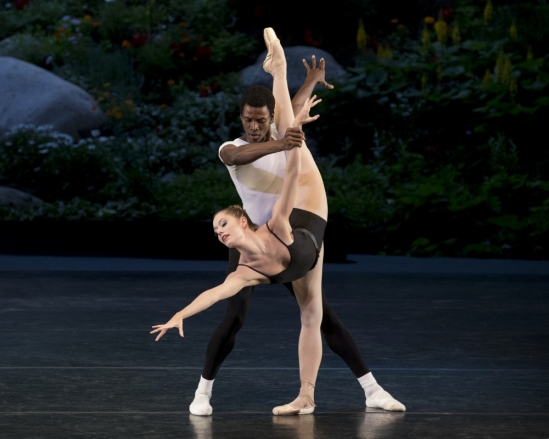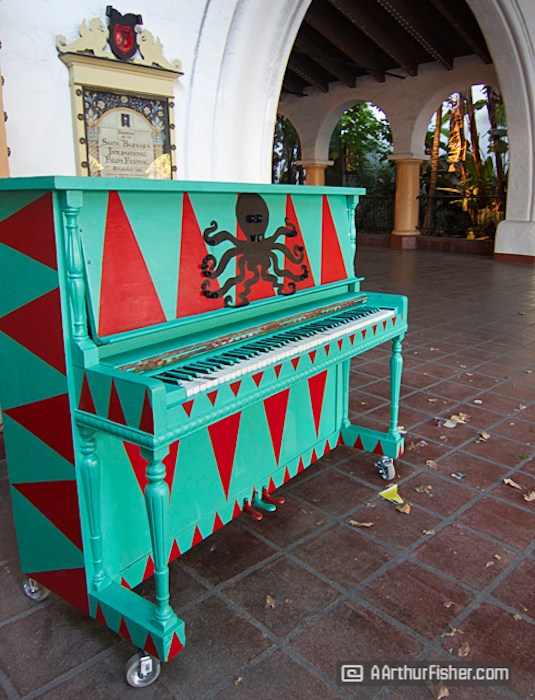Ma’s visit to Santa Barbara — which includes a free, open-to-the-public, master class with UC Santa Barbara students, and the above-mentioned lecture, “Culture, Understanding and Survival” — marks a high point for the program.
“Our relationship with Yo-Yo is very special,” said Celesta M. Billeci, A&L’s Miller McCune Executive Director. “I think it’s unique to any program in the country, and I can say with confidence he has a very special relationship with us.” That relationship, she added, extends to Chancellor Henry T. Yang and his wife, Dilling.
This season, A&L has also co-commissioned a project with the Grammy Award-winning Silkroad Ensemble, founded by Ma in 1998. The genre-defying global musicians will perform the world premiere of “Take Their Stands” Friday, April 26, at the Granada.
“This is really research in action in the arts,” Billeci said. “We gave the money to this ensemble to create new work. They’ve created five new pieces they will premiere and will tour all over the world. And we did this here at UCSB. So that’s a real testament to the quality of this program and to being a leader in the arts.”

Alvin Ailey American Dance Theater’s Yannick Lebrun and Sarah Daley. Photo Credit: ANDREW ECCLES.
During the week prior to their performance, the musicians will be on campus working with students in the music, dance and religious studies departments and in the Givertz School of Education.
For example, Silkroad members Haruka Fuji and Sandeep Das will conduct a lecture/demonstration and Kayhan Kalhor will conduct a Dastgah practicum in world music; Kojiro Umezaki and Cristina Pato will hold a workshop with Gevirtz School of Education student teachers; Ahmad Sadri and Wu Tong will lead a meet-the-artist conversation on Asian religious traditions; and Aparna Ramaswamy will share Bharatnatyam dance traditions with students in the theater and dance department.
Education, Billeci stressed, is at the heart of A&L’s programming. “Its purpose is to really be intertwined with the academic program and be a supplement for the academic experience of students on this campus,” she said. “It’s not peripheral; it’s definitely to the core of the academic mission.”
To that end, Billeci, Associate Director Roman Baratiak and their team, particularly program manager Heather Silva, work closely with academic departments and individual faculty members to set priorities for the types of lectures and performances they bring to campus. “The speakers and artists we bring are not just coming here and doing their public presentation,” explained Caitlin O’Hara, A&L writer and publicist. “They’re going to campus for class events or master classes. They’re very heavily enmeshed in the campus as part of their stay.”
Historian Doris Kearns Goodwin’s recent visit is a prime example. Prior to her public lecture she met with honors students from the College of Letters and Science. “Frankly, I think some of our speakers are shocked at how much we expect them to do,” Baratiak quipped.
“We also present a lot of free events for students,” added Billeci, noting the recent concert with ukulele wizard Jake Shimabukuro in Storke Plaza. “This is the second time we’ve had him do that. He did it before and the students went nuts for him. They just love him. And he just loves them. He’s a great ambassador for our program and for music overall.”
Plans to bring performers to A&L are often in the works years ahead of time. With the dance series, for instance, Billeci meets with faculty members several times throughout the year to understand who they are interested in having come to campus. Professors and lecturers often build class visits into their curricula, and when these companies perform, hundreds of students are in the audience.
“On our lecture side, our education coordinator will reach out to academic departments and individual faculty members and say, ‘Here’s an opportunity,’” explained Baratiak. They can elect to send their students to an event or, if time can be spared in the performer’s or presenter’s schedule, he or she might meet with students. “We have collaborations with the College of Creative Studies, the writing program, pretty much most departments,” he added.
“I think we’ve got one of the most exciting and interesting public lecture programs in the country,” said Baratiak, whose 40-year tenure with the program began when he was a student at UC Santa Barbara. “So it’s obviously something that I think all of us are proud of here at A&L.”
Baratiak is particularly enthusiastic, he added, about the annual free summer film series presented at the Santa Barbara Courthouse in collaboration with the Santa Barbara County Office of Arts and Culture.
The truth is, over the last 60 years, A&L has enabled Santa Barbara audiences to spend time with some incredible individuals and performers: Upton Sinclair, Robert Oppenheimer, Duke Ellington, Dizzy Gillespie, Bishop Desmond Tutu, Allen Ginsberg and The Dalai Lama (on three separate occasions), to name a few.
In addition to Yo-Yo Ma, A&L has more recently brought to the local stage Joan Baez, Trevor Noah, Laurie Anderson, Gloria Steinem, Bill T. Jones, the NYC Ballet, the Lincoln Center Jazz Orchestra, Sonny Rollins and Twyla Tharp.
A&L also presented talks by Pakistani activist and Nobel Prize winner Malala Yousafzai (“We were the only university in the country that got that date,” Billeci pointed out) and comedian Jon Stewart (“We presented him to 5,000 students in the Thunderdome”), and a concert by alumnus Jack Johnson, who performed at Harder Stadium.
The talk by former vice president Joe Biden at the Arlington Theater also stands out. “We were doing a free simulcast for students on the campus, and as soon as it ended he jumped in the car and came to campus to meet with the students who’d watched the simulcast,” recalled O’Hara. “He sat and talked with them. I’ve had so many students talk to me and say how impactful that was.”
Similarly, a recent — and free — lecture by Tarana Burke, founder of the #MeToo Movement, also was a high point for students, according to O’Hara. So many students wanted to hear her talk that simulcasts to overflow rooms were required to accommodate them.
“If you go back 60 years,” Billeci remarked, “this program is really really amazing.”
On the community outreach side, the A&L initiative dearest to Billeci’s heart is ¡Viva el Arte de Santa Bárbara! The program offers free performances and educational activities to students, at-risk youth and families in Santa Barbara County. “We have made the long-term commitment to bring high quality arts — not average or mediocre — the very best in music and dance to these communities and to the folks who live there,” Billeci said.
Putting on more than 100 events every year is a team effort, and Billeci is quick to credit the contributions of A&L staff, which includes roughly 75 work-study students. “Often Roman and I get a lot of credit, but this does not work without the amazing group of people that make this machine move,” she said. “For the size of this program — a nationally respected, top-five program in the country — this group of people is so dedicated and so hard working and it’s my privilege and my pleasure to work with them every day.”
More information about A&L, including and a schedule of events, is available at www.artsandlectures.ucsb.edu.
 Click here to see this story as it originally appeared in the December 2020 issue of 805 Living Magazine.
Click here to see this story as it originally appeared in the December 2020 issue of 805 Living Magazine.









